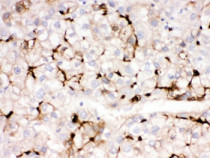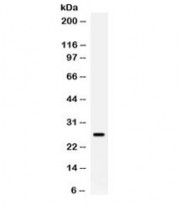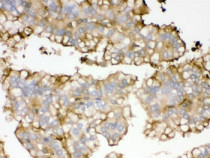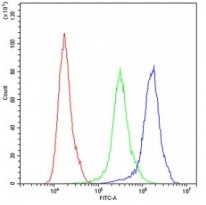ARG10770
anti-Apolipoprotein AI antibody
anti-Apolipoprotein AI antibody for Flow cytometry,IHC-Formalin-fixed paraffin-embedded sections,Western blot and Human
Overview
| Product Description | Rabbit Polyclonal antibody recognizes Apolipoprotein AI |
|---|---|
| Tested Reactivity | Hu |
| Tested Application | FACS, IHC-P, WB |
| Host | Rabbit |
| Clonality | Polyclonal |
| Isotype | IgG |
| Target Name | Apolipoprotein AI |
| Antigen Species | Human |
| Immunogen | Synthetic peptide around aa. 25-267 of Human Apolipoprotein A1. |
| Conjugation | Un-conjugated |
| Alternate Names | ApoA-I; ProapoA-I; Apo-AI; Apolipoprotein A-I; Apolipoprotein A1; 1-242 |
Application Instructions
| Application Suggestion |
|
||||||||
|---|---|---|---|---|---|---|---|---|---|
| Application Note | IHC-P: Antigen Retrieval: Citrate buffer (10 mM, pH 6.0), Boil bathing for 20 min. * The dilutions indicate recommended starting dilutions and the optimal dilutions or concentrations should be determined by the scientist. |
Properties
| Form | Liquid |
|---|---|
| Purification | Affinity purification with immunogen. |
| Buffer | PBS, 0.025% Sodium azide and 2.5% BSA. |
| Preservative | 0.025% Sodium azide |
| Stabilizer | 2.5% BSA |
| Concentration | 0.5 mg/ml |
| Storage Instruction | For continuous use, store undiluted antibody at 2-8°C for up to a week. For long-term storage, aliquot and store at -20°C or below. Storage in frost free freezers is not recommended. Avoid repeated freeze/thaw cycles. Suggest spin the vial prior to opening. The antibody solution should be gently mixed before use. |
| Note | For laboratory research only, not for drug, diagnostic or other use. |
Bioinformation
| Database Links | |
|---|---|
| Gene Symbol | APOA1 |
| Gene Full Name | apolipoprotein A-I |
| Background | This gene encodes apolipoprotein A-I, which is the major protein component of high density lipoprotein (HDL) in plasma. The protein promotes cholesterol efflux from tissues to the liver for excretion, and it is a cofactor for lecithin cholesterolacyltransferase (LCAT) which is responsible for the formation of most plasma cholesteryl esters. This gene is closely linked with two other apolipoprotein genes on chromosome 11. Defects in this gene are associated with HDL deficiencies, including Tangier disease, and with systemic non-neuropathic amyloidosis. [provided by RefSeq, Jul 2008] |
| Function | Participates in the reverse transport of cholesterol from tissues to the liver for excretion by promoting cholesterol efflux from tissues and by acting as a cofactor for the lecithin cholesterol acyltransferase (LCAT). As part of the SPAP complex, activates spermatozoa motility. [UniProt] |
| Calculated MW | 31 kDa |
| PTM | Glycosylated. Palmitoylated. Phosphorylation sites are present in the extracellular medium. |
Images (5) Click the Picture to Zoom In
-
ARG10770 anti-Apolipoprotein AI antibody IHC-P image
Immunohistochemistry: Formalin-fixed and paraffin-embedded Human liver cancer tissue stained with ARG10770 anti-Apolipoprotein AI antibody. Antigen retrieval: Citrate buffer (10mM, pH 6.0), boiling bathing for 20 min.
-
ARG10770 anti-Apolipoprotein AI antibody WB image
Western: Human placenta lysates stained with ARG10770 anti-Apolipoprotein AI antibody.
-
ARG10770 anti-Apolipoprotein AI antibody FACS image
Flow Cytometry: Caco-2 cells were blocked with goat sera and stained with ARG10770 anti-Apolipoprotein AI antibody at 1 µg/10^6 cells (blue); Cells alone (red); Isotype control (green).
-
ARG10770 anti-Apolipoprotein AI antibody IHC-P image
Immunohistochemistry: Formalin-fixed and paraffin-embedded Human kidney cancer tissue stained with ARG10770 anti-Apolipoprotein AI antibody. Antigen retrieval: Citrate buffer (10mM, pH 6.0), boiling bathing for 20 min.
-
ARG10770 anti-Apolipoprotein AI antibody FACS image
Flow Cytometry: HepG2 cells were blocked with goat sera and stained with ARG10770 anti-Apolipoprotein AI antibody at 1 µg/10^6 cells (blue); Cells alone (red); Isotype control (green).










